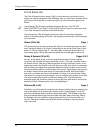
Editing Programs: Chapter 6
level until you release the note on the keyboard, or decay to 0 at the Sustain Decay
rate (which is on page 2 of the envelope). You can create a long "plateau" at the start
of a note by setting the Sustain to 98 and the Decay to 99. This will cause the
envelope to take the maximum amount of time to get from peak level to a level of 98,
before the Sustain Release portion of the envelope begins.
Release (00 to 99) Page 4
Eventually, you will let go of the note that you’ve been holding (either by releasing the
note on the keyboard, or releasing the sustain pedal if it was pressed). It is at this
point that the Release portion of the envelope takes effect. The Release is the time
that the envelope takes to get from the sustain level back down to nothing. Setting
the Release time to 0 is good for playing those short funky riffs that you hear on a
clavinet. Setting the Release time to 99 will take the envelope a very long time to
reach zero level.
Delay (00 to 99) Page 5
This is the amount of time that the envelope will wait before doing anything; very
useful if you want to affect one element of a sound sometime after the sound starts.
When the Delay is set to 0, the envelope attacks right away, without any delay. Play
some notes while turning up the delay and see that the time between playing the note
and hearing the effect of the Amp Envelope gets progressively longer as the Delay
control is turned up.
If the Delay is set above 99, the display will read “Hold”. This indicates that the Delay
stage of the envelope will wait indefinitely until the key is released before continuing
on to the remaining envelope stages (Attack, Decay, etc.). This requires that the Amp
Envelope’s Trigger parameter (see next page) is set to “Freerun”. However, when
the Delay is set to “Hold”, “Freerun” mode is forced on regardless of the Trigger
parameter’s setting.
Sustain Decay (00 to 99) Page 6
This is the amount of time that the envelope will take during the sustain stage to bring
the level down to 0. If this is set to 99, the envelope will remain at the Sustain level
until the note is released. When set to 0, the envelope’s level will immediately jump
down to 0 upon reaching the sustain stage.
Trigger (Normal, Freerun, Reset, Reset-Freerun) Page 7
The Trigger mode determines how the envelope will function. You may select either
Freerun or Reset, or both (Reset-Freerun) or neither (Normal). When set to Normal,
the envelope will always start at its current level (i.e., if another note had been played
which triggered the envelope’s cycle, playing another note in the middle would not
interrupt the cycle). Also in Normal mode, the envelope will immediately advance to
its release stage upon releasing the note. When set to Freerun, the envelope will
complete its entire cycle, even if the note is released in the middle. When set to
Reset, the envelope starts at the beginning whenever a new note is played. When set
to Reset-Freerun, the envelope will start at the beginning whenever a new note is
played and will complete its entire cycle, even if the note is released in the middle.
If a sound layer’s Keyboard Mode parameter (found in the Pitch Function, Page 10,)
is set to “Mono”, the Amp Envelope will only retrigger when playing legato if the
Trigger Mode is set to either “Reset” or “Reset-Freerun”.
QS7/QS8 Reference Manual 71


















